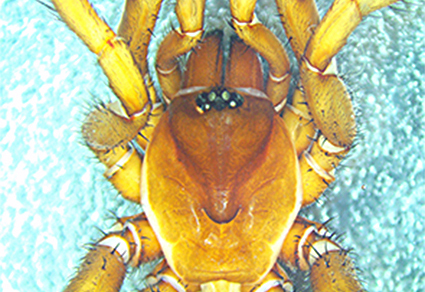Abstract
The trapdoor spider genus Eucteniza Ausserer, 1875 is distributed in North America, with most diversity in Mexico. In this work, a new species is described from the Chamela-Cuixmala Biosphere Reserve, Jalisco, Mexico: Eucteniza cuixmala sp. nov., was collected from a dry tropical deciduous forest in the western coast of Mexico. The species is described only from the male holotype. Of the 14 species of Eucteniza described so far, eight have been described based only on the male holotype. The description of this new species increases the diversity of the genus to 15 known species, 14 of which are found in Mexico, two in the USA, and one in both countries: E. relata (O. Pickard-Cambridge, 1895). In addition, we provide an amended taxonomic identification key for males of the genus.
References
- Bond, J.E. (2012) Phylogenetic treatment and taxonomic revision of the trapdoor spider genus Aptostichus Simon (Araneae, Mygalomorphae, Euctenizidae). ZooKeys, 252, 1–209. https://doi.org/10.3897/zookeys.252.3588
- Bond, J.E. & Coyle, F.A. (1995) Observations on the natural history of an Ummidia trapdoor spider from Costa Rica (Araneae, Ctenizidae). Journal of Arachnology, 23 (3), 157–164.
- Bond, J.E. & Opell, B.D. (2002) Phylogeny and taxonomy of the genera of south-western North American Euctenizinae trapdoor spiders and their relatives (Araneae: Mygalomorphae, Cyrtaucheniidae). Zoological Journal of the Linnaean Society, 136, 487–534. https://doi.org/10.1046/j.1096-3642.2002.00035.x
- Bond, J.E. & Hedin, M.C. (2006) A total evidence assessment of the phylogeny of the diverse North American trapdoor spider subfamily Euctenizinae (Araneae, Mygalomorphae, Cyrtaucheniidae). Molecular Phylogenetics and Evolution, 41, 70–85. https://doi.org/10.1016/j.ympev.2006.04.026
- Bond, J.E. & Godwin, R.L. (2013) Taxonomic revision of the Trapdoor spider genus Eucteniza Ausserer (Araneae, Mygalomorphae, Euctenizidae). ZooKeys, 356, 31–67. https://doi.org/10.3897/zookeys.356.6227
- Bond, J.E., Hendrixson, B.E., Hamilton, C.A. & Hedin, M. (2012) A reconsideration of the classification of the spider infraorder Mygalomorphae (Arachnida: Araneae) based on three nuclear genes and morphology. PloS ONE, 7 (6), e38753. https://doi.org/10.1371/journal.pone.0038753
- Bond, J.E., Hamilton, C.A., Godwin, R.L., Ledford, J.M. & Starrett, J. (2020) Phylogeny, evolution, and biogeography of the North American trapdoor spider family Euctenizidae (Araneae: Mygalomorphae) and the discovery of a new ‘endangered living fossil’ along California’s central coast. Insect Systematics and Diversity, 4 (5, 2), 1‒14. https://doi.org/10.1093/isd/ixaa010
- Ceccarelli, F.S., Garduño Villaseñor, L.A. & Hernández Salgado, L.C. (2023) Genetic diversity and population histories of two species of Phidippus (Araneae: Salticidae) from northwestern Mexico. Revista Mexicana de Biodiversidad, 94 (e945052), 1‒14. https://doi.org/10.22201/ib.20078706e.2023.94.5052
- Crews, S.C. & Hedin, M. (2006) Studies of morphological and molecular phylogenetic divergence in spiders (Araneae: Homalonychus) from the American southwest, including divergence along the Baja California Peninsula. Molecular Phylogenetics and Evolution, 38 (2), 470‒487. https://doi.org/10.1016/j.ympev.2005.11.010
- Correa-Ramírez, M., Jiménez, M.L & Garcia de León, F. (2010) Testing species boundaries in Pardosa sierra (Araneae, Lycosidae) using female morphology and COI mtDNA. Journal of Arachnology, 38 (3), 538‒554. https://doi.org/10.1636/Sh09-15.1
- González-Trujillo, R., Correa-Ramírez, M., Ruiz-Sánchez, E., Méndez-Salinas, E., Jiménez, M.L. & García de León, F. (2016) Pleistocene refugia and their effects on the phylogeography and genetic structure of the wolf spider Pardosa sierra (Araneae: Lycosidae) in the Baja California Peninsula. Journal of Arachnology, 44 (3), 367‒379. https://doi.org/10.1636/R15-84.1
- Hedin, M. & Bond, J.E. (2006) Molecular phylogenetics of the spider infraorder Mygalomorphae using nuclear rRNA genes (18S and 28S): Conflict and agreement with the current system of classification. Molecular Phylogenetics and Evolution, 41, 454–471. https://doi.org/10.1016/j.ympev.2006.05.017
- Halffter, G. (2003) Biogeografía de montaña de la entomofauna de México y América Central. In: Morrone, J.J. & Llorente-Bousquets, J. (Eds.), Una perspectiva latinoamericana de la biogeografía. UNAM, Las Prensas de Ciencias, pp. 87–97.
- Halffter, G., Favila, M.E., Arellano, L. (1995) Spatial distribution of three groups of Coleoptera along an altitudinal transect in the Mexican Transition Zone and its biogeographical implications. Elytron, 9, 151–185.
- Jiménez, M.L., Berria, J.E., Polotov, D. & Palacios-Cardiel, C. (2017) Description of Califorctenus, a new arid spider genus (Araneae, Ctenidae, Cteninae) of Mexico. Zootaxa, 4238 (1), 97‒108. https://doi.org/10.11646/zootaxa.4238.1.7
- Maya-Morales, J. & Jimenez, M.L. (2013) Rothilena (Araneae: Agelenidae) a new genus of funnel-web spiders endemic to the Baja California Peninsula, Mexico. Zootaxa 3718 (5), 441‒466. https://doi.org/10.11646/zootaxa.3718.5.2
- Maya-Morales, J., Jimenez, M.L. & Murugan, G. (2017) Four new genera of funnel-web spiders (Araneae: Agelenidae) from the Baja California Peninsula in Mexico. Journal of Arachnology, 45 (1), 30–66. https://doi.org/10.1636/JoA-S-16-024.1
- Morrone, J.J. (2014) Cladistic biogeography of the Neotropical region: identifying the main events in the diversification of the terrestrial biota. Cladistics, 30, 202–214. https://doi.org/10.1111/cla.12039
- Morrone, J.J., Escalante, T. & Rodriguez-Tapia, G. (2017) Mexican biogeographic provinces: Map and shapefiles. Zootaxa, 4277 (2), 277–279. https://doi.org/10.11646/zootaxa.4277.2.8
- Opatova, V., Hamilton, C.A., Hedin, M., De Oca, L.M., Král, J. & Bond, J.E. (2020) Phylogenetic systematics and evolution of the spider infraorder Mygalomorphae using genomic scale data. Systematic Biology, 69 (4), 671–707. https://doi.org/10.1093/sysbio/syz064
- Raven, R.J. (1985) The spider infraorder Mygalomorphae (Araneae): cladistics and systematics. Bulletin of the American Museum of Natural History, 182, 1–175.
- Riddle B.R., Hafner, D.J., Alexander, L.F. & Jeger, J.R. (2000) Cryptic vicariance in the historical assembly of a Baja California peninsula Desert Biota. Proceedings of the National Academy of Sciences of the United States of America, 97, 14438–14443. https://doi.org/10.1073/pnas.250413397
- Shorthouse, D.P. (2010) SimpleMappr, an online tool to produce publication-quality point maps. Available from: http://www.simplemappr.net (accessed 29 April 2024)
- Valdez-Mondragón, A. & Cortez-Roldán, M.R. (2016) On the trapdoor spiders of Mexico: description of the first new species of the spider genus Aptostichus from Mexico and the description of the female of Eucteniza zapatista (Araneae, Mygalomorphae, Euctenizidae). ZooKeys, 641, 81–102. https://doi.org/10.3897/zookeys.641.10521
- World Spider Catalog (2024) World Spider Catalog. Version 25.0. Natural History Museum Bern, Bern. Available from: http://wsc.nmbe.ch (accessed 3 April 2024) https://doi.org/10.24436/2


